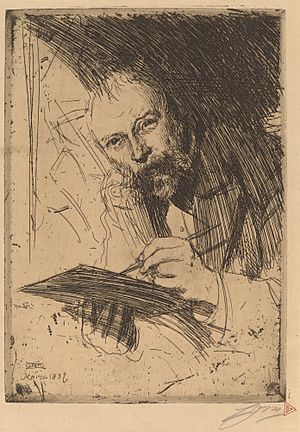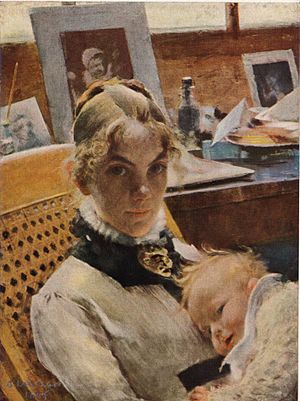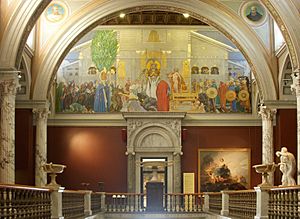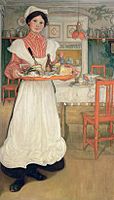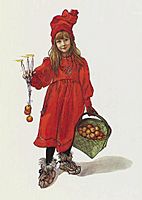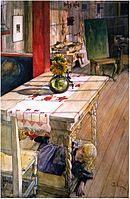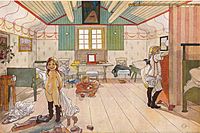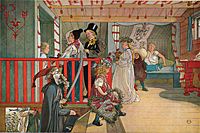Carl Larsson facts for kids
Quick facts for kids
Carl Larsson
|
|
|---|---|
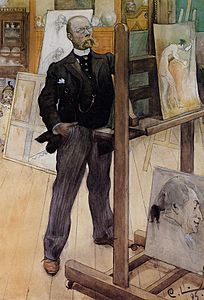
Self-portrait (1895)
|
|
| Born | 28 May 1853 |
| Died | 22 January 1919 (aged 65) |
| Nationality | Swedish |
| Education | Royal Swedish Academy of Arts |
| Known for | Painting Writing |
| Signature | |
 |
|
Carl Olof Larsson (28 May 1853 – 22 January 1919) was a famous Swedish painter. He was part of the Arts and Crafts movement, which focused on traditional craftsmanship. Carl Larsson created many artworks, including oil paintings, watercolors, and frescoes (wall paintings).
He is best known for his beautiful watercolors that show happy scenes of family life. Carl Larsson thought his most important work was a large painting called Midvinterblot (Midwinter Sacrifice). You can see this painting today at the Swedish National Museum of Fine Arts.
Contents
Carl Larsson's Life Story
Early Years and School
Carl Larsson was born on May 28, 1853, in Stockholm, Sweden. His family was very poor, and his childhood was quite tough.
Despite these challenges, Carl's talent was noticed early on. When he was thirteen, his teacher at a school for poor children encouraged him to apply to the Royal Swedish Academy of Arts. He was accepted into this important art school.
At first, Carl felt a bit out of place and shy at the academy. But by 1869, when he was sixteen, he moved up to the "antique school" section. There, he became more confident and even a popular student. To help his family, Carl also worked as a caricaturist for a funny newspaper called Kasper. He also drew pictures for another newspaper, Ny Illustrerad Tidning. His earnings helped his parents a lot.
His Art Career
After working for several years illustrating books and magazines, Carl Larsson moved to Paris in 1877. He spent a few years there trying hard to become a successful artist, but it was difficult. He didn't join the new art movements like Impressionism that were popular in France at the time.
In 1882, Carl joined other Swedish artists in Grez-sur-Loing, a small village outside Paris. This place was known for artists who liked to paint outdoors. Here, he met another artist named Karin Bergöö (1859–1928). She soon became his wife, and this meeting changed his life and art forever. In Grez, Carl started using watercolours, which was a big change from the oil paintings he used to do.
Carl and Karin Larsson had eight children: Suzanne, Ulf, Pontus, Lisbeth, Brita, Mats, Kersti, and Esbjörn. His family became his favorite models for his paintings. Many of the beautiful rooms he painted were designed by Karin, who was also a talented interior designer.
In 1888, Karin's father gave the young family a small house called Little Hyttnäs. It was in Sundborn, a village near Falun in Dalarna. Carl and Karin decorated this house with their unique artistic style, making it perfect for their growing family. Through Carl's paintings and books, Little Hyttnäs became one of the most famous artist's homes in the world. It showed off their artistic taste and influenced Swedish interior design. Today, Carl and Karin Larsson's descendants still own the house, now called Carl Larsson-gården. It's open for visitors every summer.
Carl Larsson passed away in January 1919 in Falun. He was buried in the cemetery of Sundborn Church.
Carl Larsson's Paintings
Carl Larsson's art became much more popular in the 1890s. This was thanks to new color printing technology. A Swedish publisher released books written and illustrated by Larsson, like A Home. These books had full-color pictures of his watercolors.
Later, a German publisher named Karl Robert Langewiesche released a book called Das Haus in der Sonne (The House in the Sun) in 1909. This book, filled with Carl Larsson's watercolors, drawings, and text, became a huge bestseller in Germany. It sold 40,000 copies in just three months! Carl and Karin Larsson were amazed by its success.
Carl Larsson believed his most important works were his large paintings for public buildings, like schools and museums. His last big work was Midvinterblot (Midwinter Sacrifice). This huge oil painting, about 6 by 14 meters (20 by 46 feet), was finished in 1915. It was meant for a wall in the Swedish National Museum of Fine Arts in Stockholm. The painting shows an ancient blót (sacrifice) of King Domalde at the Temple of Uppsala.
However, when it was finished, the museum's board didn't want it. Years later, the painting was bought and finally placed in the National Museum, where it is today.
About Midvinterblot
In his memoirs, Jag (I), published after he died, Carl Larsson wrote about how sad and disappointed he was when Midvinterblot was rejected. He felt it was his greatest achievement. He wrote, "The fate of Midvinterblot broke me! This I admit with a dark anger." But he also believed that one day, after he was gone, the painting would be honored.
In the same book, Larsson also said that his paintings of his family and home "became the most immediate and lasting part of my life's work." He explained that these pictures truly showed his personality and his deep love for his wife and children.
The debate over Midvinterblot went on for many years. In 1987, the museum was even offered the painting for free, but they still said no. So, it was sold to a Japanese collector. In 1992, the collector lent it to the museum for a big Carl Larsson exhibition. It was hung in the spot it was originally meant for. People loved it, and this changed the experts' minds. With help from donations, the museum bought the painting in 1997. Now, it is permanently displayed in the National Museum, exactly where Carl Larsson wanted it to be.
Gallery
-
Brita as Iduna, lithograph, 1901
See also
 In Spanish: Carl Larsson para niños
In Spanish: Carl Larsson para niños



